Transpiration is defined as water loss in the form of water vapor from the internal tissues of aerial parts of the plant body under the influence of sunlight and regulated to some extent by the cell’s protoplasm.
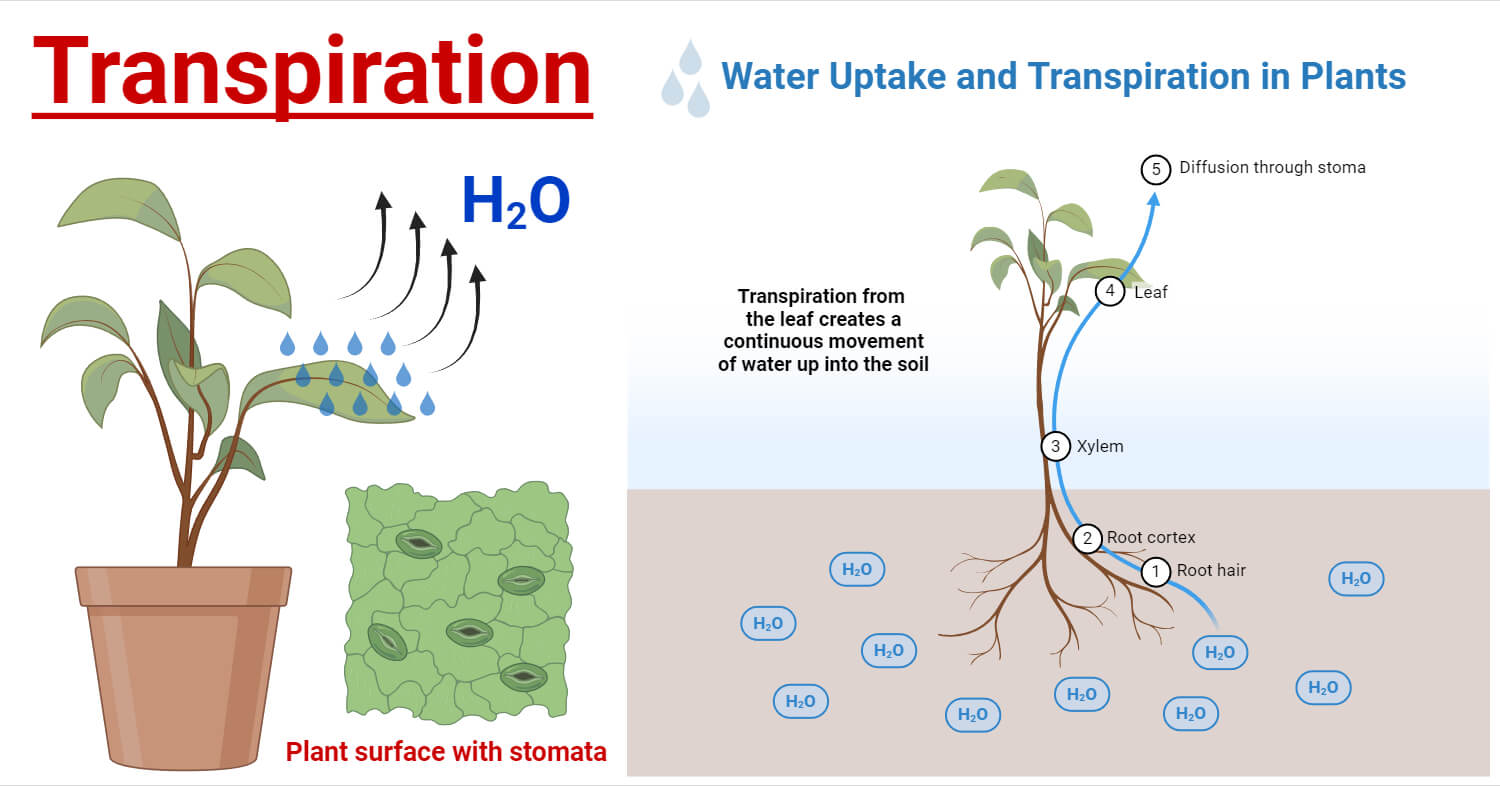
Of the total amount of water, absorbed by the plant body, only about 1% or less than 1% is utilized in metabolic activities. In contrast, the rest of the water is lost through transpiration.
Interesting Science Videos
Types of Transpiration
1. Stomatal transpiration
Stomatal transpiration is the process of water loss in the form of water vapor through the internal tissues of the plant body through minute pores called stomata. Stomatal transpiration constitutes about 80-90% of the total water lost during transpiration. Stomata are minute pores present in the epidermis of aerial parts of the plant body that remain guarded by two guard cells.
2. Cuticular transpiration
Cuticular transpiration is the process of loss of water in the form of water vapor through the internal tissues of the plant body through the cuticular surface of the plant body. It constitutes about 3-10% of the total water lost during transpiration. The cuticle is a waxy coating present on the epidermis of aerial parts of the plant body. The thinner the cuticle, the higher the rate of transpiration. Hence, in shade plants (sciophytes), cuticular transpiration contributes about 50% of the total water lost during transpiration.
3. Lenticular transpiration
It is the process of water loss in the form of water vapor through the internal tissues of plant body through the internal tissues of the plant body about 0.5% of total water lost during transpiration. Lenticels are minute pores present in the periderm of the stem of plants and consist of loosely arranged complementary cells.
4. Bark transpiration
It is the process of water loss in the form of water vapor through the internal tissues of the plant body through the bark of the plant body. It contributes more than lenticular transpiration as the surface area of the bark is larger.
5. Stomatal transpiration
Stomata are minute pores present in the epidermis of aerial parts of the plant body. Each stoma consists of a pore called a stomatal aperture which remains guarded by two specialized epidermal cells called the guard cells. The epidermal cells that join the guard cells are called subsidiary cells. Just below the stomatal aperture lies the sub-stomatal cavity. The sub-stomatal cavity opens the outside through the stomatal aperture. The guard cells are bean-shaped or kidney-shaped in dicots and dumbbell-shaped in monocots. The inner wall of the guard cell is thick while the outer wall is thin. The guard cells contain a distinct nucleus with numerous chloroplast in it.
In a dorsiventral leaf (dicot leaf), the number of stomata is more on the lower surface (dorsal surface) compared to the upper surface (ventral surface) of the leaf. However, in the iso-bilateral leaf (monocot leaf), the number of stomata is more or less equal on both surfaces of the leaf. In the free-floating leaves like lotus, and water lilies, the stomata are found only on the ventral surface of the leaf. In the leaves of totally submerged hydrophytes like Hydrilla, stomata are absent.
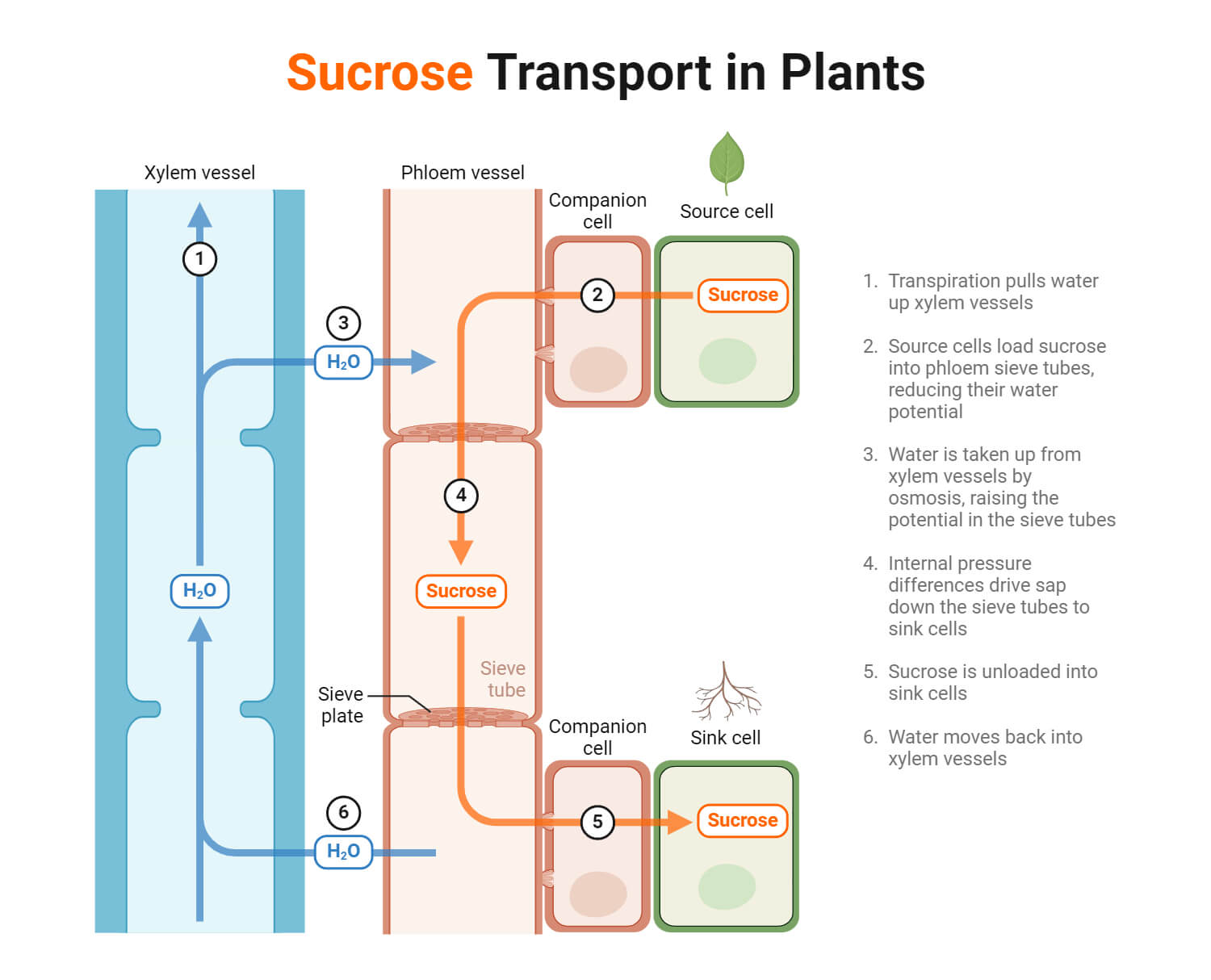
Mechanism of Transpiration
Transpiration occurs in two steps:
First step of Transpiration
In the first step, there is the evaporation of water from the cell wall of turgid mesophyll cells into the sub-stomatal cavity or inter-cellular spaces. The evaporated water gets collected in the sub-stomatal cavity in the form of water vapor. This increased the water vapor pressure called density of the sub-stomatal cavity.
Second step of Transpiration
In the second and final step, there is the diffusion of water vapor from the sub-stomatal cavity into the outer atmosphere through the open stoma. The diffusion occurs because the water vapor pressure of the sub-stomatal cavity is higher than that of the outer atmosphere.
About 80-90% of the total water lost during transpiration occurs through stomatal transpiration, the mechanism of transpiration is the opening and closing of stomata. The stoma opens when the guard cells are turgid and the stoma closes when the guard cells are flaccid. This difference in behavior is due to the difference in the thickness of the outer and inner walls of the guard cells.
When water enters the guard cells, the outer thin wall of the guard cell extends more in the outward direction which in turn pulls the inner thick wall outward too. This causes the stoma to open. However, when water moves out of the guard cells, the guard cells become flaccid and the stoma closes. Generally, the stoma opens during the day and closes during the night.
Mechanism of opening and closing of stomata
Various theories have been proposed to explain the mechanism of opening and closing of stomata. Some of the theories are as follows-
Classical starch hydrolysis theory (Starch-Sugar interconversion theory)
This theory is an outcome of two separate theories proposed by Lloyd and Sayre.
During the day time, photosynthesis occurs and the carbon dioxide present in the guard cell is utilized in photosynthesis. This increases the pH of the guard cells. At the increased pH, the enzyme phosphorylase converts starch into glucose-1-phosphate. The glucose-1-phosphate is converted into glucose-6-phosphate with the help of the enzyme phosphoglucomutase. The glucose-6-phosphate is converted into glucose with the help of enzyme phosphatase.
As glucose is soluble in water, it increases the osmotic concentration of the guard cell. This increases the osmotic pressure of the guard cell. So, water from the subsidiary cells enters the guard cells by endosmosis. This makes the guard cell turgid and the stoma opens.
During the nighttime, photosynthesis stops and carbon dioxide accumulates in the guard cell. This decreases the pH of the guard cell. At this decreased pH, the glucose is converted back into starch. As starch is insoluble in water, the osmotic pressure of the guard cells decreases. This causes exosmosis of the guard cells so the guard cells become flaccid and the stoma closes.
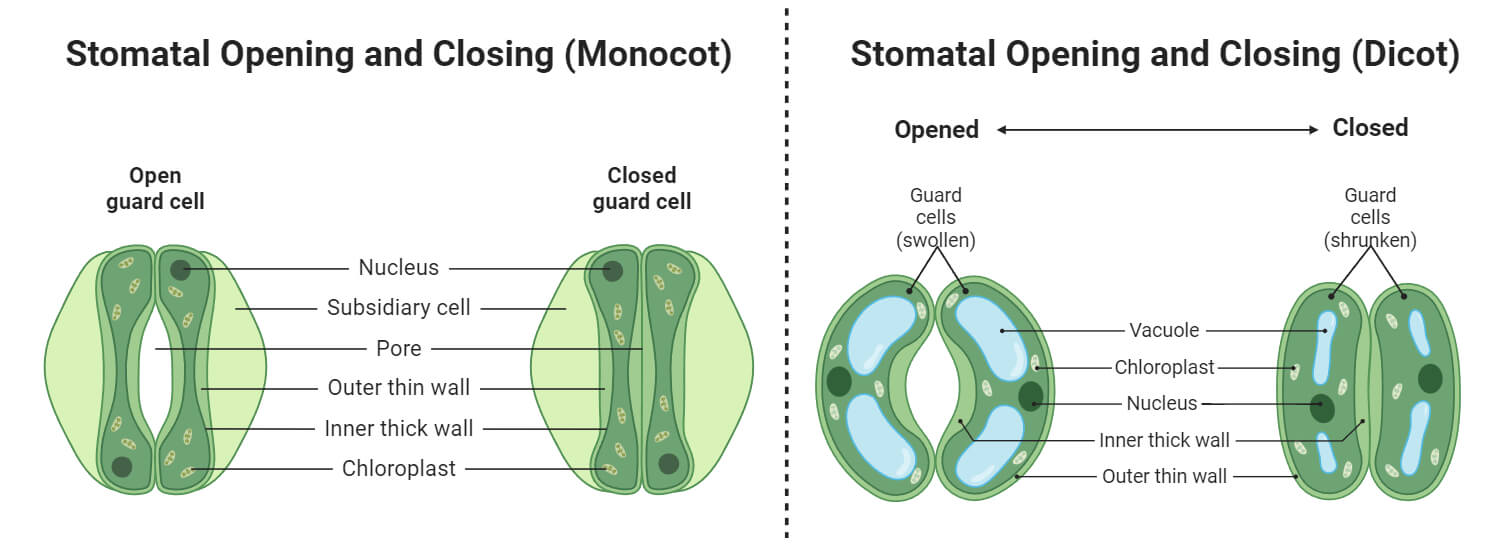
Active Potassium Ion Transport Theory
This is the most accepted theory. It was proposed by Fujino.
During Daytime:
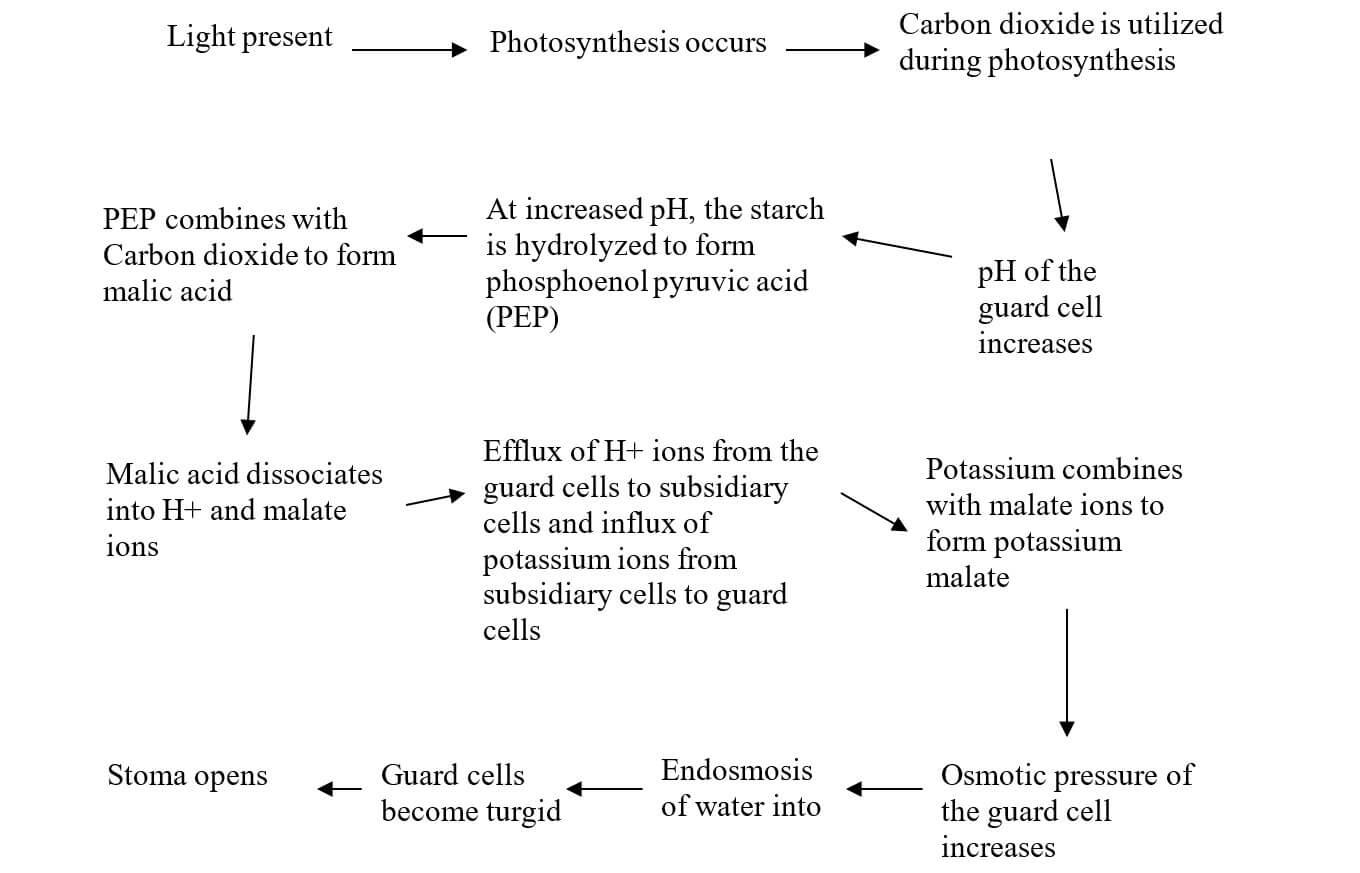
During the daytime, the carbon dioxide present in the guard cell is utilized during photosynthesis. This increases the pH of the guard cell. At increased pH, starch is hydrolyzed to form phosphoenol pyruvic acid (PEP). PEP combines with carbon dioxide to form malic acid which dissociates into H+ and malate ion. Now, the efflux of H+ ions from guard cells to subsidiary cells, and the influx of K+ ions from subsidiary cells into guard cells occurs. The K+ ion combines with malate ion to form potassium malate which increases the osmotic pressure of the guard cells. So, water enters into the guard cells by endosmosis. This makes the guard cells turgid and the stoma opens.
During Nighttime:
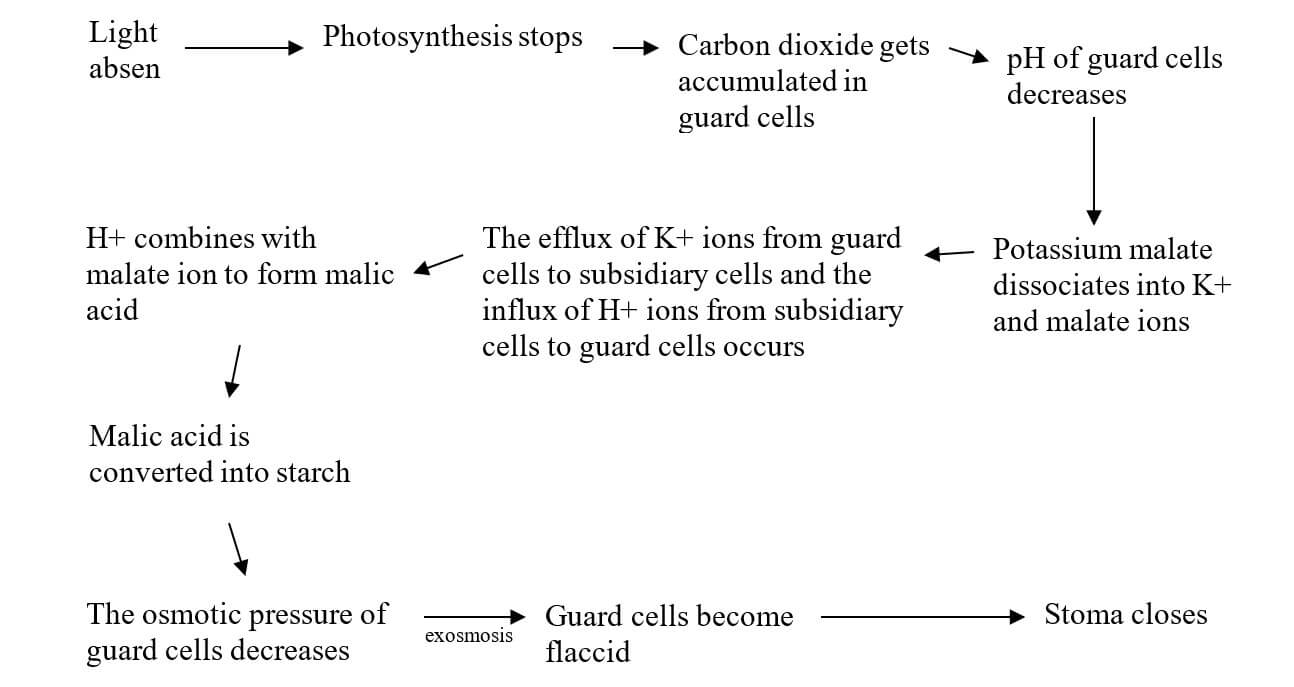
During nighttime, photosynthesis stops and carbon dioxide accumulates in the guard cells. This decreases the pH of the guard cell. This decreases the pH of the guard cell. At decreased pH, potassium malate dissociates into K+ and malate ions. Now, the efflux of K+ ions from guard cells into subsidiary cells and the influx of H+ ions from subsidiary cells into guard cells.
Anti-Transpirants
Anti-Transpirants are those substances that are applied to the plant body to reduce the rate of transpiration. There are two types:
Barrier-forming substances
These are those anti-transpirants that form a barrier or a film around the plant body, that is only permeable to carbon dioxide and oxygen, not to water vapor.
Examples: transparent plastic sheets, low-viscosity wax, and silicone oils.
Metabolic inhibitors
These are those anti-transpirants that bring partial or complete closure of the stomata.
Examples: carbon dioxide, ABA (abscisic acid), PMA (phenyl mercuric acetate).
Demonstration of Process of Transpiration by Bell Jar Method
Requirements
Apparatus: The bell jar, Polythene paper, thread
Materials: A healthy potted plant
Chemicals: Vaseline
Theory
Plants absorb water from the soil but only a part of that water is utilized. The surplus water is given off in the form of water vapor from the aerial parts of the plant/ This process of evaporation of surplus water from the internal tissue through the aerial parts of the plant such as leaves, and green shoots is known as transpiration.
Procedure
Take a well-watered potted plant. Cover the soil surface of the pot with polythene paper and tie it around the neck of the pot with a thread. Place the pot on a glass plate and cover it with a clean and dry bell jar. Apply Vaseline to the edges of the bell jar to prevent the entry of moisture from the outside atmosphere. Expose the setup to sunlight for a few hours or leave it for 24 hours.
Observation
Water vapor begins to deposit on the inner wall of the bell jar in the form of small water droplets.
Explanation and Conclusion
The water vapor soon gets saturated inside the bell jar and condenses into water droplets. As there is no possibility of water vapor coming from outside or the soil surface, the aerial parts of the plant are the only source of released vapor. This concludes that water vapor is given off during transpiration.
Precautions
- The inner wall of the bell jar should be completely dry.
- The potted plant should be well watered.
Factors affecting Transpiration
Numerous factors directly and indirectly affect the rate of loss of water from the plant body. While some factors increase the rate of transpiration, some factors can lower the transpiration rate. Factors affecting transpiration are categorized into two:
External Factors Affecting Transpiration
External factors are environmental factors and they can be manipulated by humans to form a desired outcome in a controlled laboratory environment. They include the following-
- Light
- Temperature
- Humidity
- Wind velocity
- Carbon dioxide concentration in the air
- Atmosphere
- Water content in the soil
- Solute concentration in soil water
Light
The role of transpiration is directly proportional to light. Light helps in the opening of the stomata. Strong light also causes a heating effect.
Temperature
The high temperature helps in the opening of the stomata. Similarly, the high temperature reduces the relative humidity of the air.
Humidity
The rate of transpiration is inversely proportional to the relative humidity of the air. If the concentration of water vapor is higher in the atmosphere than in the leaf, the vapor can’t diffuse outside so the rate of transpiration is low.
Carbon dioxide in air
High amounts of carbon dioxide act as an anti-transpirant.
Atmospheric pressure
Low atmospheric pressure increases evaporation, produces air currents, and increases the rate of transpiration.
Solute concentration in soil water
The rate of transpiration is equivalent to the rate of water absorption. Soil factors like soil water, soil temperature, soil air, etc also influence the absorption of water resulting in an influence on the transpiration rate.
Wind velocity
The movement of air increases the rate of transpiration.
Water contained in soil
The rate of transpiration can be maintained only if adequate water is absorbed by the roots from the soil to make up for the loss.
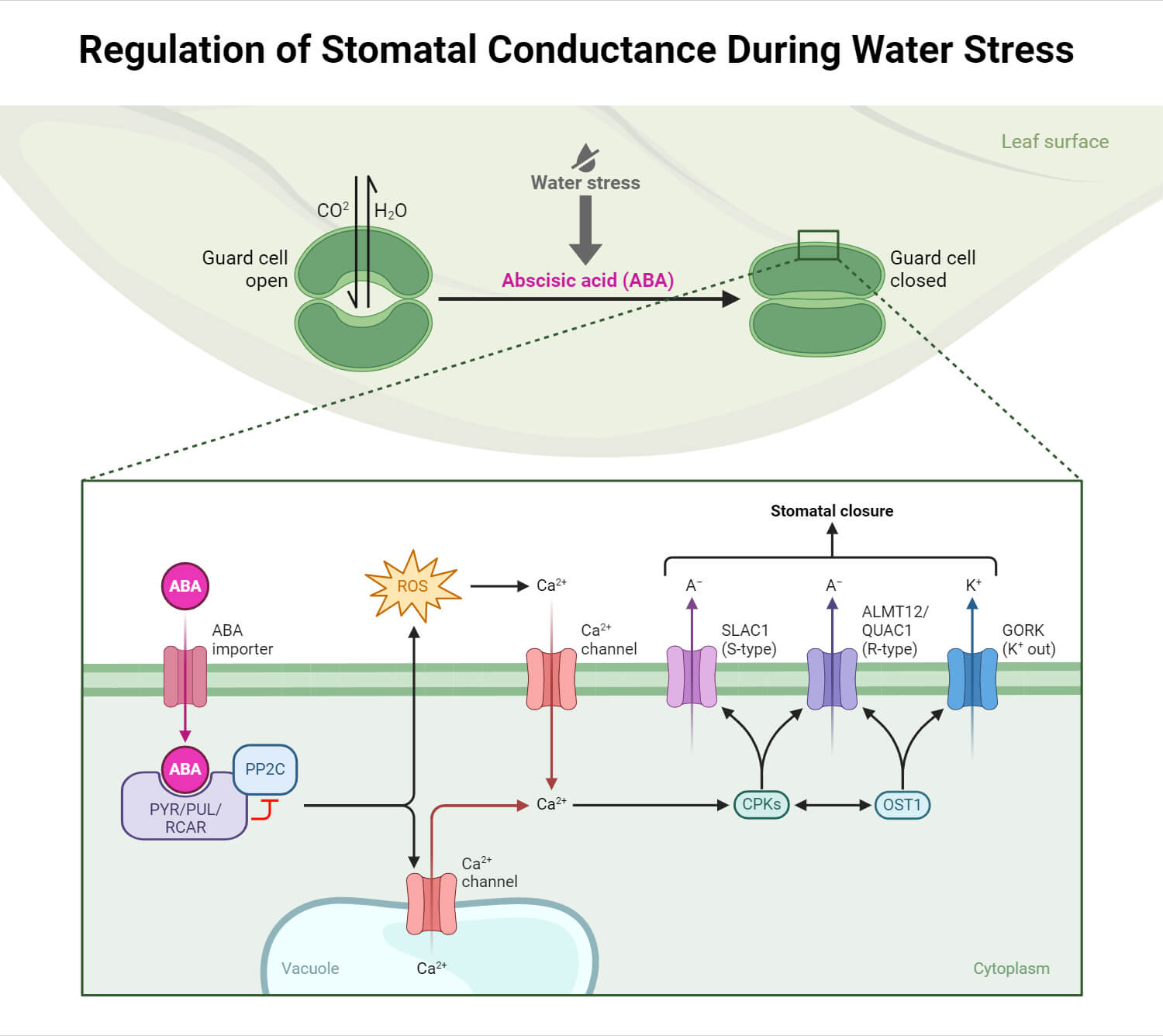
Internal Factors Affecting Transpiration
Transversely, internal factors are intrinsic factors or genetic factors that naturally occur. They can’t be manipulated but through genetic mutation, desired plants with fixed internal factors can be produced. The internal factors that affect the rate of transpiration include the following:
- Transpiration area
- Thickness of cuticle
- Stomatal frequency
- Root-Shoot ratio
- Sunken stomata
Transpiration area
The transpiration area of a plant refers to the surface area of its leaves. A larger leaf surface area means more sites for water vapor to escape through stomata, leading to increased transpiration rates. Plants that have more leaves have greater transpiration rates as they have a higher stomatal number and larger surface area. Similarly, the stomatal size also plays a role by directly increasing the transpiration rate.
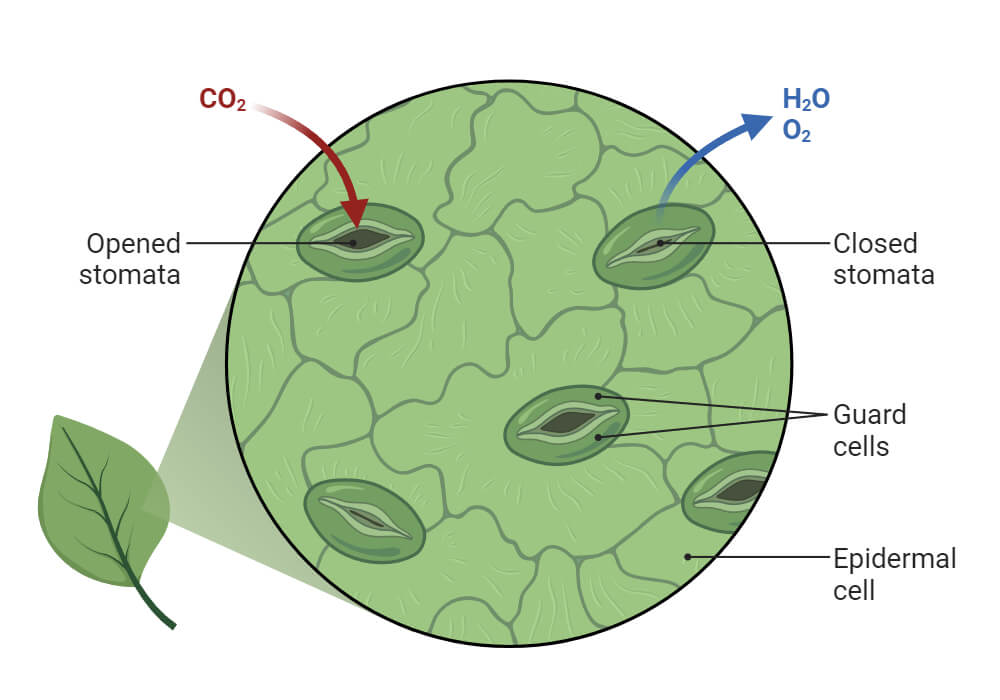
The thickness of the cuticle
The cuticle is the outermost layer of the epidermis of the leaf and it has a significant impact on the rate of transpiration. A thicker cuticle acts as a barrier that reduces transpiration as shown in the bell jar experiment. This is because it blocks the movement of water vapor from the leaf cells to the environment. On the other hand, a thinner cuticle allows for rapid transpiration because water vapor diffuses easily.
Stomatal frequency
Stomatal frequency directly influences the rate of transpiration. As the number of stomata of a leaf increases, the surface area for transpiration increases.
Root-shoot ratio
The root-shoot ratio is inversely proportional to the rate of water loss. A high root-shoot ratio indicates more water being retained in the roots than in the shoot area, which results in to decrease in the rate of transpiration.
Sunken stomata
Sunken stomata reduce the rate of transpiration. The depressed position of the stomata creates a barrier by limiting the movement of water vapor.
References
- Smith, J.A.C. (1991), Ion Transport and the Transpiration Stream. Botanica Acta, 104: 416-421. https://doi.org/10.1111/j.1438-8677.1991.tb00252.x
- https://www.sciencedirect.com/science/article/abs/pii/016953479390257P
- Smith, W.K., Geller, G.N. Leaf and environmental parameters influencing transpiration: Theory and field measurements. Oecologia 46, 308–313 (1980). https://doi.org/10.1007/BF00346257
- Clements HF. SIGNIFICANCE OF TRANSPIRATION. Plant Physiol. 1934;9(1):165-172. doi:10.1104/pp.9.1.165
- Jones, H. G. (1998). Stomatal control of photosynthesis and transpiration. Journal of Experimental Botany, 49, 387–398. http://www.jstor.org/stable/23695972
- Transpiration and water stress. (2002). Taylor & Francis. https://doi.org/10.1201/9780203910092-11
- Transpiration – What and Why? | Transpiration – Water Movement through Plants – passel. (n.d.). https://passel2.unl.edu/view/lesson/c242ac4fbaaf/3
- Transpiration – Definition, process, types, structure of stomata. (2020, May 20). Toppr-guides. https://www.toppr.com/guides/biology/transport-in-plants/transpiration/
- Petruzzello, M. (2024, March 14). Transpiration | Definition, Mechanism, & Facts. Encyclopedia Britannica. https://www.britannica.com/science/transpiration
